B3
 |
| Engine code |
B3 |
| Engine type |
Otto, Front transversal |
| Number of cylinders |
4, In-line |
| Engine capacity |
1324 cm3 |
| Number of valves |
16 SOHC |
| Fuel |
Petrol, Injection by cylinder |
| Supercharging |
None |
| Bore |
71 mm |
| Stroke |
83.6 mm |
| Compression ratio |
9.4 |
| Max Power |
53 kW (ECE) 5500 rpm |
| Max torque |
108 Nm (rpm) 4000 rpm |
| Performance |
| Top speed |
162 km/h (167 km/h) |
| Acceleration 0-100 km/h |
15.3 s (14.2 s) |
| Consumption |
| In the city |
9.5 l/100 km |
| Out of city |
6.2 l/100 km |
| Average consumption |
7.4 l/100 km (Werk) |
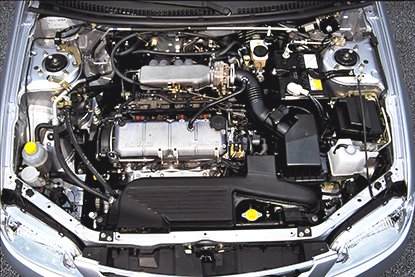
|
|
|
B3-ME
 |
| Model for the domestic market |
| Engine code |
B3-ME |
| Engine type |
Otto, Front transversal |
| Number of cylinders |
4, In-line |
| Engine capacity |
1323 cm3 |
| Number of valves |
16 SOHC |
| Fuel |
Petrol, Injection by cylinder |
| Supercharging |
None |
| Bore |
71 mm |
| Stroke |
83.6 mm |
| Compression ratio |
9.4 |
| Max Power |
63 kW (JIS) 6000 rpm |
| Max torque |
110 Nm (rpm) 4400 rpm |
| Consumption |
| Average consumption |
5.7 l/100 km // 6,8 (Auto) |
|
|
|
FP
 |
| Engine Code |
FP |
| Engine type |
Otto, Front transversal |
| Number of cylinders |
4, In-line |
| Engine capacity |
1840 cm3 |
| Number of valves |
16 DOHC |
| Fuel |
Petrol, Injection by cylinder |
| Bore |
83.0 mm |
| Stroke |
85.0 mm |
| Compression ratio |
9.1:1 (9.7:1 for EDM PFL FP) |
| Max Power |
84 kW (DIN) 6000 rpm |
| Max torque |
161 Nm (rpm) 4000 rpm |
| 0-100kmh |
10,1 secs |
| Vmax |
194 km/h |
| Consumption |
| In the city |
9.0 l/100 km // 9.5 l/100 km (Auto) |
| Out of city |
6.4 l/100 km // 7.0 l/100 km (Auto) |
|
|
|
FP-DE
 |
| Engine Code |
FP-DE |
| Engine type |
Otto, Front transversal |
| Number of cylinders |
4, In-line |
| Engine capacity |
1840 cm3 |
| Number of valves |
16 DOHC |
| Fuel |
Petrol, Injection by cylinder |
| Bore |
83.0 mm |
| Stroke |
85.0 mm |
| Compression ratio |
9.1:1 (9.6:1 for SAfrica) |
| Max Power |
92 kW (DIN) @ 6000 rpm
90 KW @ 6000 rpm (USA Protegé, SAfrica Etude)
100 kW @ 6200 rpm (Japan) |
| Max torque |
163 Nm @ 4000 rpm / 161 Nm @ 4500 rpm |
| Consumption |
| In the city |
9.0 l/100 km // 9.5 l/100 km (Auto) |
| Out of city |
6.4 l/100 km // 7.0 l/100 km (Auto) |
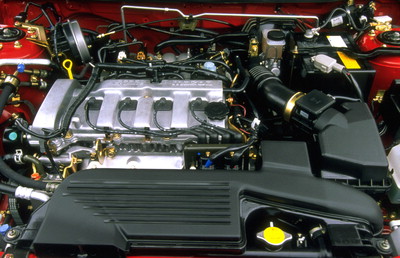
|
|
|
FS
 |
| Engine code |
FS |
| Engine type |
Otto, Front transversal |
| Number of cylinders |
4, In-line |
| Engine capacity |
1991 cm3 |
| Number of valves |
16 DOHC |
| Fuel |
Petrol, Injection by cylinder |
| Supercharging |
None |
| Bore |
83.0 mm |
| Stroke |
92.0 mm |
| Compression ratio |
9.7 |
| Max Power |
96 kW (ECE) 6000 rpm |
| Max torque |
171 Nm (rpm) 4500 rpm |
| Performance |
| Top speed |
203 km/h |
| Acceleration 0-100 km/h |
9.7 s |
| Consumption |
| In the city |
11.2 l/100 km |
| Out of city |
6.9 l/100 km |
| Average consumption |
8.5 l/100 km (EU) |
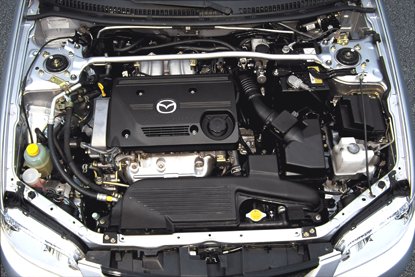
for details on VICS & VTCS look at the FS-DE model
|
|
|
FS-DE
 |
| Engine code |
FS-DE |
| Engine type |
Otto, Front transversal |
| Number of cylinders |
4, In-line |
| Engine capacity |
1991 cm3 |
| Number of valves |
16 DOHC |
| Fuel |
Petrol, Injection by cylinder |
| Supercharging |
None |
| Bore |
83.0 mm |
| Stroke |
92.0 mm |
| Compression ratio |
9.1:1 (96kw) // 9.7:1 (98kw) |
| Max Power |
96 kW (ECE) 6000 rpm |
| Max torque |
171 Nm (rpm) 4500 rpm |
| Additional Info |
USA Version has: OBD-2, VICS+VTCS
AUS Version has: OBD-1, VICS, no VTCS |
|
|
|
VTCS variable tumble control system):
The intake manifold found on the stock 2.0l and 1.8l CA spec Protegé’s have the VTCS component designed to control cold start emissions to help achieve the ULEV Emissions standard (Also other European emission standards). This same system also causes some minor restrictions and air turbulence in the intake manifold runners.
VICS (variable inertial charge system):
By setting the precise length of the inlet pipe to ensure an even blend of fuel vapour with air and optimising air pressure, maximum energy and perfect burn is delivered. To boost torque at higher speeds. Conceptually, it is like a variable valve timing system (but is not the same thing) in that it allows more air to be drawn in at speeds above 4750 rpm, thereby keeping the torque curve at a higher level rather than falling off. |
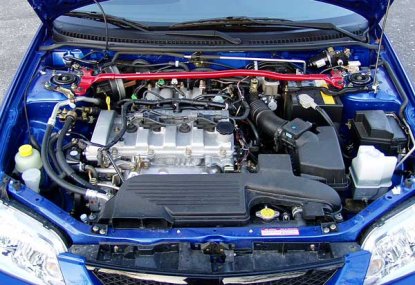
|
|
|
FS-DET
 |
| Engine Code |
FS-DET |
| Engine type |
Otto, Front transversal |
| Number of cylinders |
4, In-line |
| Engine capacity |
1986 cm3 |
| Number of valves |
16 DOHC |
| Fuel |
Petrol, Injection by cylinder |
| Supercharging |
Garrett T25R Turbo + Intercooler |
| Bore |
83.0 mm |
| Stroke |
92.0 mm |
| Compression ratio |
9.1 |
| Max Power |
125 kW (JIS) 6000 rpm |
| Max torque |
217 Nm (rpm) 3500 rpm |
| Consumption |
| In the city |
9.8 l/100 km |
| Out of city |
7.8 l/100 km |
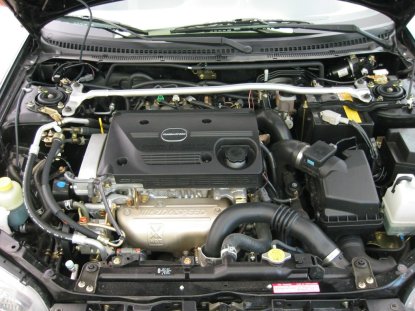
|
|
|
FS-ZE
 |
| Model for the domestic market |
| Engine code |
FS-ZE |
| Engine type |
Otto, Front transversal |
| Number of cylinders |
4, In-line |
| Engine capacity |
1991 cm3 |
| Number of valves |
16 DOHC |
| Fuel |
Petrol, Injection by cylinder |
| Supercharging |
None |
| Bore |
83.0 mm |
| Stroke |
92.0 mm |
| Compression ratio |
10.4 |
| Max Power |
121 kw FS-ZE for Mazda Familia 2.0 @ 6800rpm
125 kw FS-ZE for Mazdaspeed Familia @ 6800 rpm |
| Max torque |
177 (180 Nm FS-ZE for JDM Mazdaspeed) @ 5000 rpm |
| Consumption |
| Average consumption |
8.1 l/100 km (Werk) |
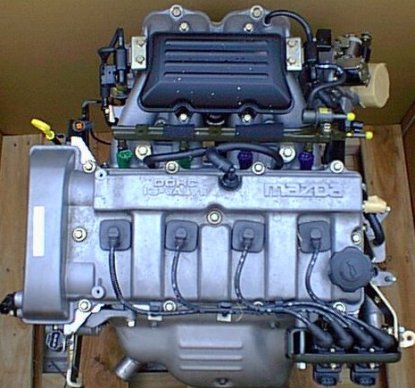
|
|
|
RF IDI
52kw
 |
| Engine Code |
RF-IDI |
| Engine type |
Diesel, Front transversal |
| Number of cylinders |
4, In-line |
| Engine capacity |
1998 cm3 |
| Number of valves |
16 OHC |
| Fuel |
Diesel |
| Max Power |
52 kW (ECE) 4500 rpm |
| Max Torque |
200 nm 2000rpm |
|
|
|
RF TDI
66kw
 |
| Engine Code |
RF-TDI |
| Engine type |
Diesel, Front transversal |
| Number of cylinders |
4, In-line |
| Engine capacity |
1998 cm3 |
| Number of valves |
16 OHC |
| Fuel |
Diesel, Direct injection Diesel |
| Supercharging |
IHI (RHF3-VJ27-A) Turbo + Intercooler
Turbo Part Number: RF2B-13-700A |
| Bore |
86 mm |
| Stroke |
86 mm |
| Compression ratio |
18.8:1 |
| Max Power |
66 kW (ECE) 4000 rpm |
| Max torque |
220 Nm (rpm) 2000 rpm |
| Performance |
| Top speed |
178 km/h |
| Acceleration 0-100 km/h |
12.2 s |
| Consumption |
| In the city |
6.4 l/100 km |
| Out of city |
4.4 l/100 km |
| Average consumption |
5.1 l/100 km (Werk) |
|
|
|
RF TDI
74kw
 |
| Engine Code |
RF-TDI |
| Engine type |
Diesel, Front transversal |
| Number of cylinders |
4, In-line |
| Engine capacity |
1998 cm3 |
| Number of valves |
16 OHC |
| Fuel |
Diesel, Direct injection Diesel |
| Supercharging |
IHI (RHF3-VJ30-A) Turbo + Intercooler
Turbo Part Number: RF4F-13-700 |
| Bore |
86 mm |
| Stroke |
86 mm |
| Compression ratio |
18.8:1 |
| Max Power |
74 kW (ECE) 4000 rpm |
| Max torque |
230 Nm (rpm) 2000 rpm |
| Performance |
| Top speed |
189 km/h |
| Acceleration 0-100 km/h |
12.2 s |
| Consumption |
| In the city |
7.5 l/100 km |
| Out of city |
5.0 l/100 km |
| Average consumption |
5.9 l/100 km (Werk) |
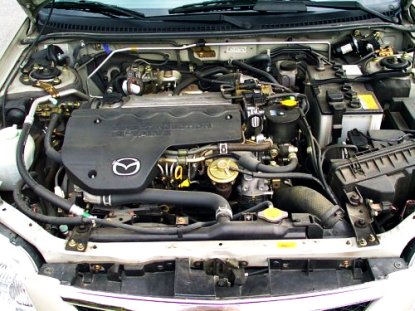
|
|
|
ZL
 |
| Engine code |
ZL |
| Engine type |
Otto, Front transversal |
| Number of cylinders |
4, In-line |
| Engine capacity |
1498 cm3 |
| Number of valves |
16 DOHC |
| Fuel |
Petrol, Injection by cylinder |
| Supercharging |
None |
| Bore |
78 mm |
| Stroke |
78.4 mm |
| Compression ratio |
9.4:1 |
| Max Power |
65 kW (JIS) 6000 rpm |
| Max torque |
132 Nm (rpm) 4000 rpm |
| Performance |
| Top speed |
177 km/h |
| Acceleration 0-100 km/h |
11,9 sec |
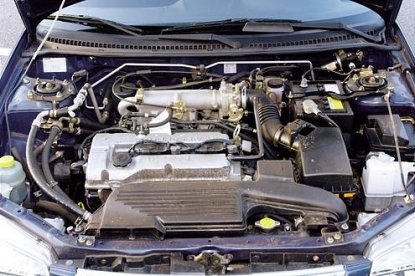
|
|
|
ZL-DE
 |
| Model for the domestic market |
| Engine code |
ZL-DE |
| Engine type |
Otto, Front transversal |
| Number of cylinders |
4, In-line |
| Engine capacity |
1498 cm3 |
| Number of valves |
16 DOHC |
| Fuel |
Petrol, Injection by cylinder |
| Supercharging |
None |
| Bore |
78 mm |
| Stroke |
78.4 mm |
| Compression ratio |
9:1 |
| Max Power |
81 kW (JIS) 6000 rpm |
| Max torque |
137 Nm (rpm) 4000 rpm |
| Transmission & Drive |
| Drive |
front-wheel drive // all-wheel drive |
| GearBox |
5 Manual // 4 Auto |
| Consumption |
| Average consumption |
5.8 l/100 km (Werk) (FWD Manual)
6.8 l/100 km (Werk) (4WD Manual)
6.8 l/100 km (Werk) (FWD Auto)
8.1 l/100 km (Werk) (4WD Auto) |
|
|
|
ZL-VE
 |
| Model for the domestic market |
| Engine code |
ZL-VE |
| Engine type |
Otto, Front transversal |
| Number of cylinders |
4, In-line |
| Engine capacity |
1498 cm3 |
| Number of valves |
16 DOHC |
| Fuel |
Petrol, Injection by cylinder |
| Supercharging |
None |
| Bore |
78.0 mm |
| Stroke |
78.4 mm |
| Compression ratio |
9.4 |
| Max Power |
96 kW (JIS) 7000 rpm |
| Max torque |
141 Nm (rpm) 4000 rpm |
| Transmission & Drive |
| Drive |
front-wheel drive |
| GearBox |
5 Manual / 4 Auto |
| Steering type |
Electric power |
| Consumption |
| Average consumption |
6.2 l/100 km (Werk)
6.8 l/100 km (Werk) (Auto) |
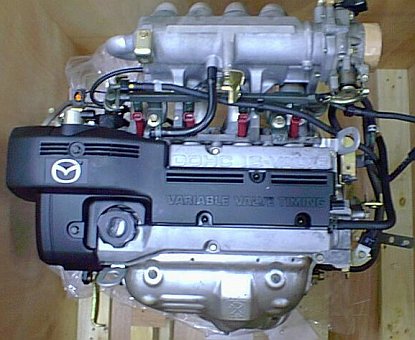
|
|
|
ZM
 |
| Engine Code |
ZM |
| Engine type |
Otto, Front transversal |
| Number of cylinders |
4, In-line |
| Engine capacity |
1598 cm3 |
| Number of valves |
16 DOHC |
| Fuel |
Petrol, Injection by cylinder |
| Supercharging |
None |
| Bore |
78 mm |
| Stroke |
83.6 mm |
| Compression ratio |
9.7 |
| Max Power |
72 kW (ECE) 5500 rpm / 70kw (ECE) 5500rpm (AT4) |
| Max torque |
145 Nm (3700 rpm) |
| Transmission & Drive |
| GearBox |
5 Manual / 4 Auto |
| Performance |
| Top speed |
182 km/h |
| Acceleration 0-100 km/h |
11.6 s / 14.7 (Auto) |
| Consumption |
| In the city |
9.6 l/100 km // 11.3 l/100 km (Auto) |
| Out of city |
6.3 l/100 km // 7.1 l/100 km (Auto) |
| Average consumption |
7.5 l/100 km (Werk) // 8.6 l/100 km (Werk) (Auto) |
|
|
|
The EuroSpec ZM engine has VICS* (That’s why the intake manifold looks different from the US ZM-DE).
*VICS (variable inertial charge system):
By setting the precise length of the inlet pipe to ensure an even blend of fuel vapour with air and optimising air pressure, maximum energy and perfect burn is delivered. To boost torque at higher speeds. Conceptually, it is like a variable valve timing system (but is not the same thing) in that it allows more air to be drawn in at speeds above 4750 rpm, thereby keeping the torque curve at a higher level rather than falling off.
Special Note: Juan from www.HiBoost.com has developed a really nice kit for the 1.6 ZM engines ..
Stock: 82 WHP
Safe Boost: ۱۷۸ WHP @ 9psi (0,62 bar)
Top Boost: ۲۹۰ WHP @ 22 psi (1,5 bar).
He’s telling that the stock internals of the ZM engines are much more stronger than on the FS 2.0 engines, so if you got the money for a Turbokit: go and get it ! The standard transmission (F25M-R) will take about 200WHP, the automatic tranny (FN4A-EL) a little less…. |
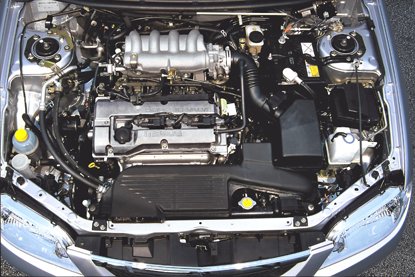 |
|
|
|
ZM-DE
 |
| Engine Code |
ZM-DE |
| Engine type |
Otto, Front transversal |
| Number of cylinders |
4, In-line |
| Engine capacity |
1598 cm3 |
| Number of valves |
16 DOHC |
| Fuel |
Petrol, Injection by cylinder |
| Bore |
78.0 mm |
| Stroke |
83.6 mm |
| Compression ratio |
9.0:1 (9.4:1 for SAfrica models) |
| Max Power |
78 kW (76kw for ULEV) (DIN) 5500 rpm |
| Max torque |
145 Nm (143Nm for ULEV / 142Nm for SAfrica)
(rpm) 4000 rpm |
| Transmission & Drive |
| GearBox |
5 Manual / 4 Auto |
| Consumption |
| In the city |
8.0 l/100 km / 9.0 l/100 km (Auto) |
| Out of city |
6.0 l/100 km / 6.6 l/100 km (Auto) |
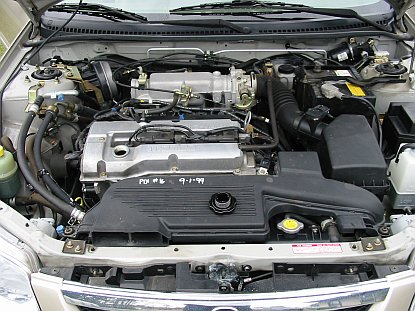 Special comments: look at the ZM engine model above. Special comments: look at the ZM engine model above.
|
|
|
S-VT
 |
| Continuous Phased Variable Valve Timing Mechanism
S-VT (sequential valve timing) controls the valve timing in various driving modes, through continually varying the opening and closing timing of the intake valve, to give the most suitable operation. It goes without saying that the application of this control technology has simultaneously improved both the performance of the engine and its fuel efficiency, and Mazda has built this brand new mechanism into its small mass-sales car, the Familia, as its main engine (the ۱.۵L ZL-VE type introduced in 1998). CO2 emissions have been reduced by 16% and NOx by 14% over previous models, while the pleasure of driving the car has increased.
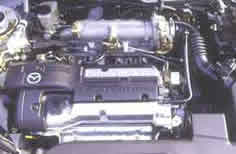 S-VT engine
S-VT engine
Maximum output: 130ps/7000rpm. Maximum torque: 14.4kg-m/4000rpm |
S-VT is composed of a vane actuator, which continually varies the phase of the intake valve timing and the crank angle through oil pressure, along with a computer, which calculates the intake valve timing, and an oil control valve (OCV), which controls the oil pressure in accordance with instructions from the computer. The most appropriate valve timing control can be achieved through detection of the engine’s revolutions, intake volume and water temperature. NOx emissions are also reduced, through the implementation of EGR.
 Diagram of Composition of S-VT System
Diagram of Composition of S-VT System |
|
|
|
Garrett
 |
T25R Turbocharger on the MSP
Garrett Turbocharger System
Garrett is the largest manufacturer of turbochargers in the world, providing engine boosting systems that save fuel and reduce emissions while providing an increase to engine performance. Garrett’s turbocharging business has sustained its reputation for innovating turbocharger technologies generation after generation. From its long list of industry firsts to its leading-edge ball bearing turbos for racecars, Garrett develops and manufactures the same cutting-edge boosting expertise that goes into all Garrett products.
Most of the world ‘ s top engine and car manufacturers, including Mazda, employ Garrett turbochargers to boost their engines, and with 27,000 turbos produced every day, Garrett is a name to trust. The T25R ball bearing turbocharger featured on the Mazda Protegé uses some of the same technologies as seen in the Garrett Motorsports product line. Interesting facts about the T25R ball bearing turbo include:
The ball bearing turbos have less rotating friction than traditional journal bearing turbos. This increases turbine efficiency which allows the turbo to ‘come up on boost’ earlier and more predictably. This translates into enhanced throttle response (crisper).
The T25R turbo’s ball bearing cartridge is much stronger and more durable than an ordinary journal bearing turbo. As long as the driver maintains his Protegé by changing his engine oil at regular intervals, the turbo will likely outlast the life of the engine.
The T25R has a high temp compressor wheel and a turbine housing cast out of an innovative high temp material (Ductile Ni-Resist) to further improve the durability of the turbo. The end result is that the turbine housing will be nearly impervious to warpage and cracking.
The water cooling lines that run to the turbo allow the unit to resist the traditional ‘coking’ of oil during hot engine shut-downs. When the engine is shut down and the turbo is still very hot, a thermal syphon is created in the turbo water jacket. This has the effect of thermally pumping water through the turbo to keep it cool.
GARRET WEBSITE // SITE2 |
|
|
Ethanol
 |
E10 Ethanol can be used in some BJ engines |

مطالب این بخش از سایت http://www.protege323.com استخراج شده است. |
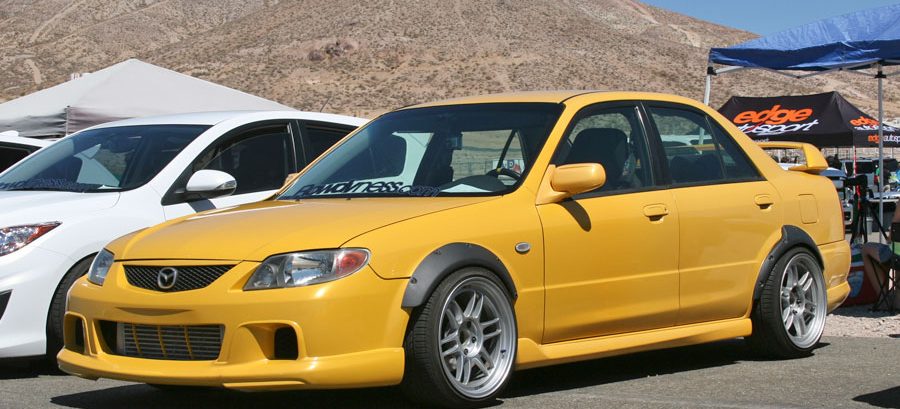











 Special comments: look at the ZM engine model above.
Special comments: look at the ZM engine model above.
